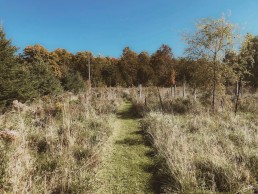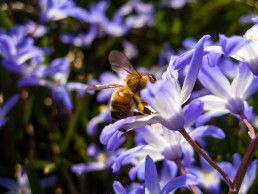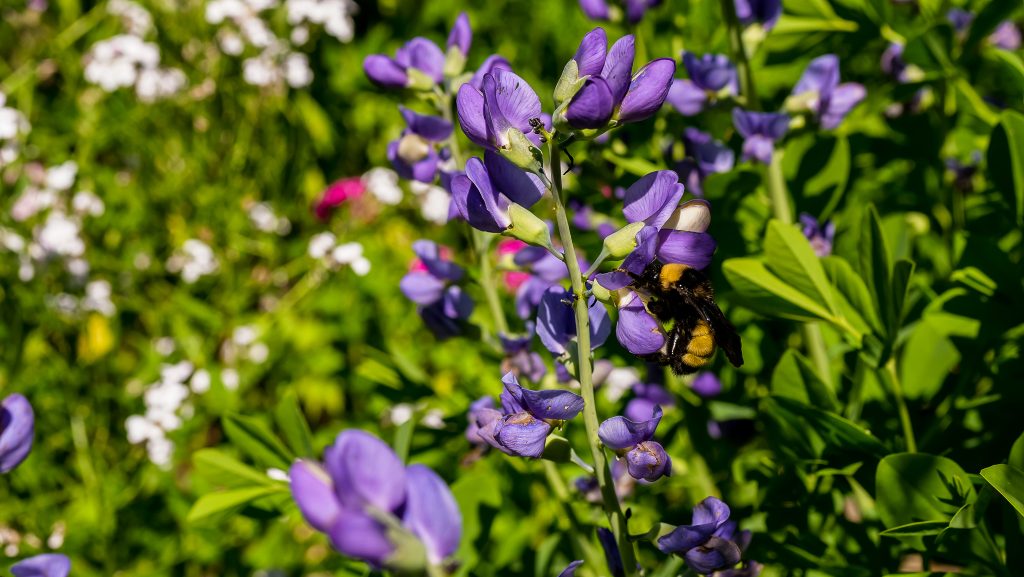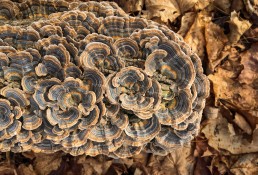For the Love of Our Landscapes
Manicured Gardens and Lawns
For so long, most western societies have valued groomed lawns and manicured gardens; those considered beautiful for their lack of weeds, crisp edges and often symmetrical landscaping. Having lived in urban areas most of my life, it wasn’t until moving to the Bruce Peninsula that I felt a sense of belonging, being surrounded by many other wild and weedy places. However, as our climate continues to change, more and more people are in search of ways to change course from the predicted direction we are headed for.
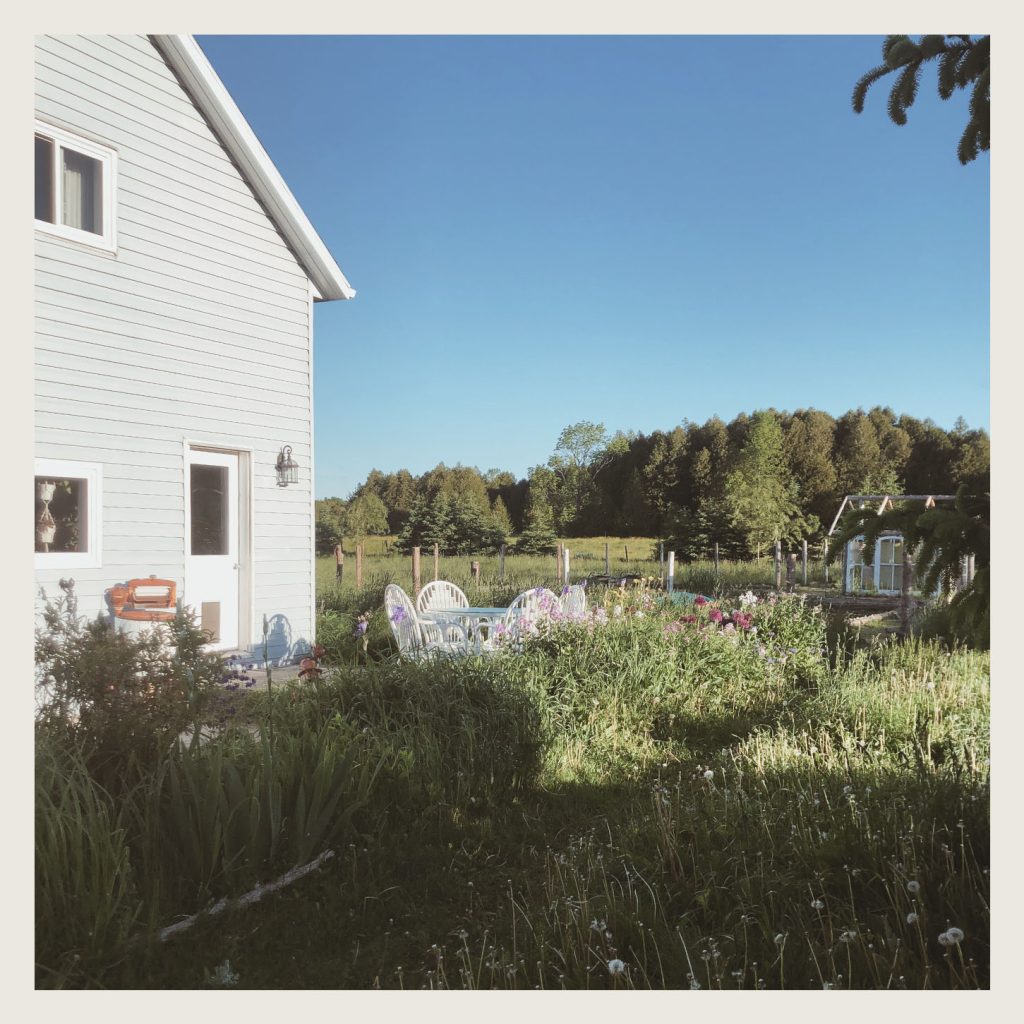
Depending on where you live, some of these impacts may be more noticeable, and in other places, less so. However, on a global scale, many parts of the world are experiencing the effects of rising sea levels, extreme temperatures and warming oceans. Our climate here in Canada is warming twice as fast as the global average. Biodiversity and habitat loss may also be observed, as the conditions of our own health continue to change, while the landscapes around us do too.
Though there are many clever and remarkable ways conservationists are trying to slow the pace of climate change (including the implementation of nature-based solutions and other effective area-based conservation measures), recognizing that many individuals and organizations are implementing strategies to reduce waste and emissions, I would argue that now is time for a change of narrative and for redefining the admirable qualities of the lands that surround us. Whether it be our backyards, community gardens or city parks, these are all opportunities to work together in support of a regenerative way forward, paying respect to every element of life that can help us fight climate change.
Of course, allowing for a wilder landscape is only one of the many actions we can take, it is one that has a cascade of positive outcomes. By creating these naturalized spaces, more land is being added to wildlife corridors (which can exist in different scales and ways), where all forms of life — mammals, birds, fish, amphibians and reptiles — can migrate, feed and drink, and we are connecting more habitats for them to move through as they continue through their different stages of life. Corridors may not have to be continuous, large or perfect to still help.
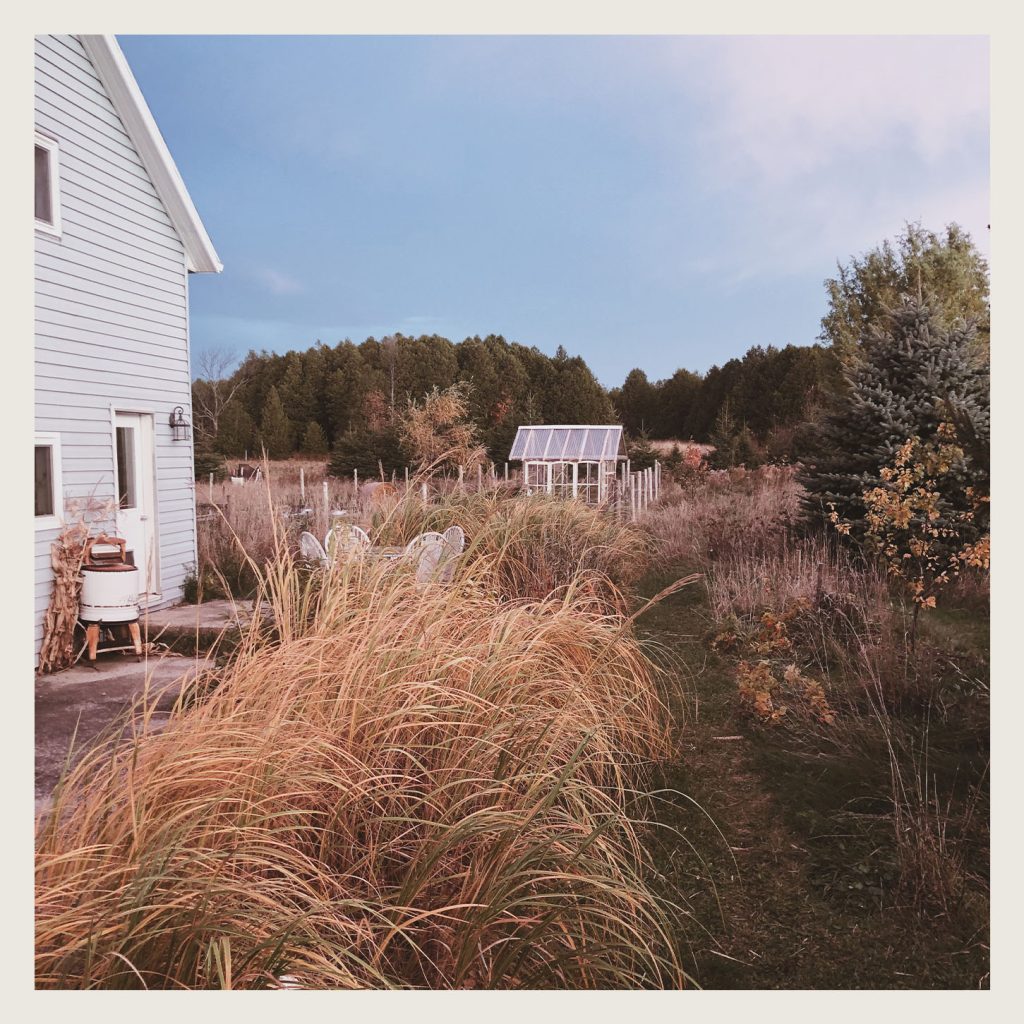
A part of my lawn where only a walking path is mowed and other tall grasses, asters, black-eyed Susans, and more are allowed to flourish
The Impact on Our Own Land
Living in a household surrounded by a naturalized lawn on the Bruce Peninsula of southwestern Ontario, I’ve witnessed these words that I share come to life. Since mowing only enough space for walking paths, planting a vegetable garden and a firepit, my family and I have been able to give back just under half a hectare of land to nature in hopes of creating a small, but thriving, ecosystem. The birdsong, combining melodies of meadowlarks, buntings, blue and blackbirds, sparrows and robins, cheers us along, as we continue to tend to the abundance of new-to-us species — black-eyed Susan, common yarrow, gray goldenrod, and a colourful variety of asters (to name but a few). Though this requires some work, these efforts promote a yard that is, in many ways, self-sufficient.
Another approach to consider is creating a food forest, or planting a diverse array of edible species, in an attempt to mimic the ecosystems and patterns found in nature. This will typically include canopy layers of fruit and nut trees, berry bushes and shrubs, herbaceous plants valuable for food and medicine, ground covers, and, at the root layer, fungi and harvestable root vegetables (this is also a great opportunity to learn what’s native to your area, and to incorporate habitat for species at risk). This concept considers the many necessary layers for maintaining symbiotic relationships, from the tallest tree to the ground below while also creating food for those doing the planting and the species passing through.
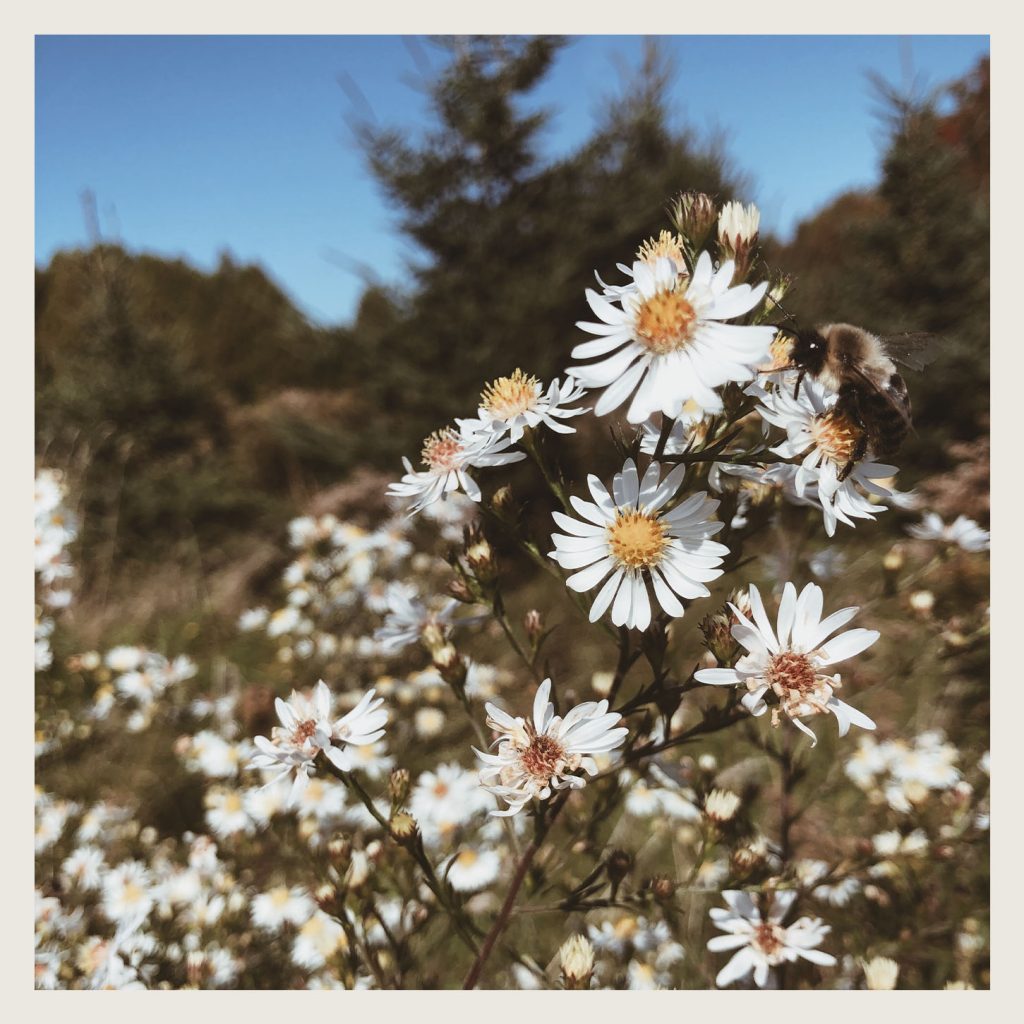
In some cases, municipalities have bylaws about what you can do with your outside areas, ensuring you meet a standard or level of care throughout your subdivision or community. Finding out what policies exist can be a great way to spark change.
Other Ways to Contribute
All this said, more and more people today are taking up residence in urban areas, including suburban neighbourhoods with little to no backyard, condos and apartments, group and community housing. This doesn’t mean you can’t make a difference, though! Along with starting conversations and sparking change, community gardens are another great addition to wildlife corridors, and they usually start thanks to the efforts of one or few people. This can be a great way to build community in an effort toward a viable and more biodiverse future, which will further awareness of the importance of maintaining our greenspaces.
Change doesn’t happen overnight. I encourage you to take a look around you. See the landscapes, both large and small, as opportunities to create food, habitats and pathways for those we share our world with, and remember that we are only as resilient as our ecosystems.
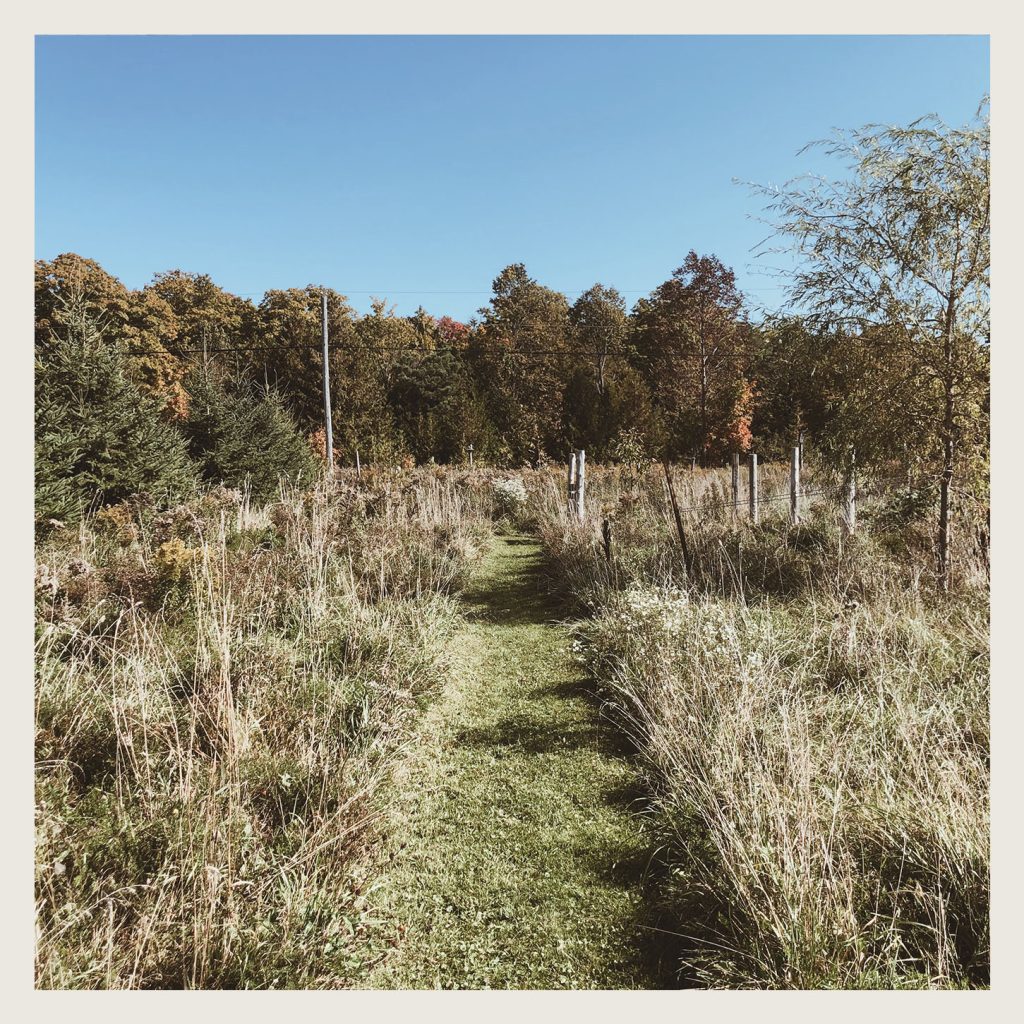
Photos Provided by Chelsea Vieira
Preparing our Hives for the Colder Days Ahead
Welcome to Our Winter Beehive
Now that snow covers the ground where we live, I know that even though I can’t see them, the honeybees are still working hard within the hive’s four walls. Up until now, on any day warm enough to do so, they continued to collect and store food for the winter, and utilized propolis to fill in any cracks or openings to minimize the potential for drafts and cold air getting in. During this time, the colonies also downsize, determining who stays and who goes, reining in their numbers for the colder days ahead.
Foresight, I think, is something the honeybees know all about, thinking always and planning for the future.
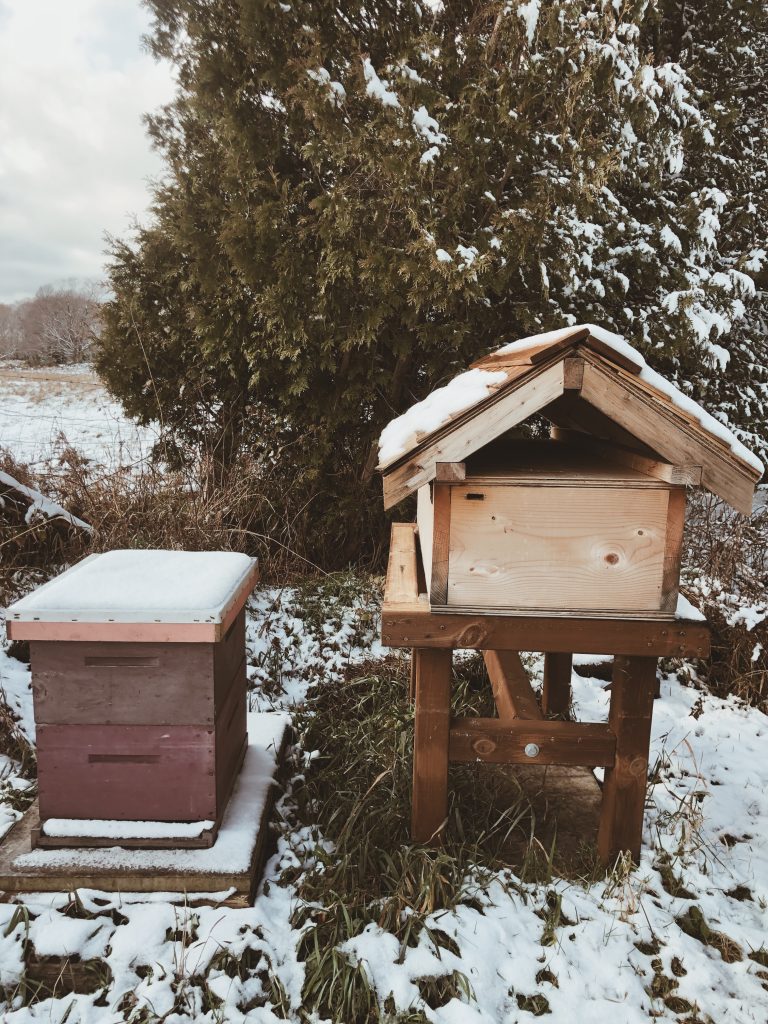
In efforts to try and help keep our honeybees alive, after two consecutive years of losing them to the Varroa mite, we are hopeful going into this winter. The Varroa mite, which hadn’t been introduced to North America until the 1980s, has been an ongoing problem for most beekeepers in our area. This parasitic mite feeds on the honeybee, attaching itself to the honeybee like a tick, until it overcomes them.
Varroa Mites
Most beekeepers use thymol-based products, which are said to help keep them at bay. However, our first year of beekeeping we thought this seemed unnecessary, giving notion to the idea that they have long since survived without the use of our man-made chemicals. We discovered the following Spring the little red spots, which at closer look, we knew to have been the mite we had not done anything to prevent. That being said, still being new to beekeeping, we looked at this unfortunate circumstance as a learning opportunity, a way we could look into the hive more closely than we could have, had they survived. The second year, we used the recommended strips, but again the Varroa mites got the best of them.

This year, we thought we ought to do something different. In the process of trying to learn as much as we can, we came across the works of Michael Bush and Leo Sharashkin. In addition to speaking to local beekeepers and a good friend, Bella Donna, after some time and a little leg work, we built a second hive.
“…each little thing you can do makes a difference”
Our second hive works horizontally, as opposed to the traditional Langstroth hive, which stands tall, vertically stacking boxes, the type of hive you will most often see, driving by farms and down country roads. In contrast, this new hive we built in the spring sits honeycomb filled frames side by side, in a long row. With two-inch thick walls, as opposed to the 3/4“ walls, we hope to better insulate the hive without having to add any exterior casing. Some other modifications we made were creating only one entrance, hence reducing the potential for invaders and allowing the bees to more easily guard the opening. Our hive sits roughly two and a half feet off the ground, helping to prevent small mammals from sneaking their way in and stops us from needing an entrance reducer – a piece of wood which you’d typically insert into the opening of a traditional hive that spans the width of the box. Our frames, where the bees build and fill honeycomb, also have had their plastic backings removed, as it was suggested to us that the size of these molded plastic pieces is the ideal size for Varroa to lay their eggs in. It has been said that each little thing you can do makes a difference, if only increasing their odds by a percent at a time.
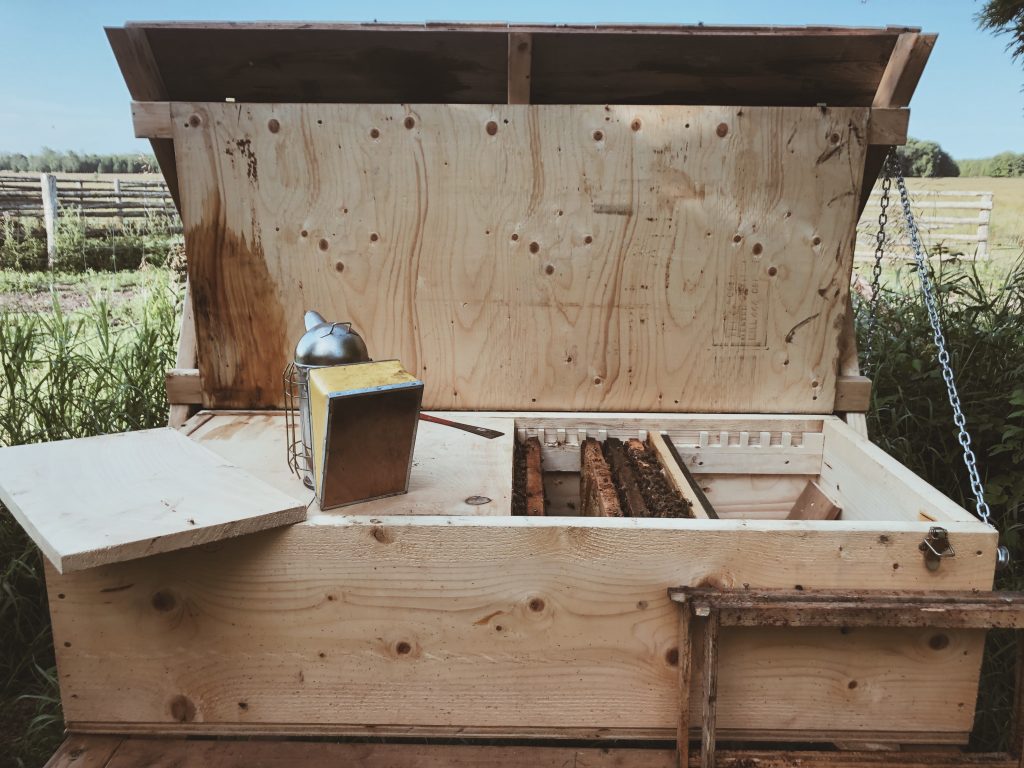
So in preparation for winter this year, we prepared our old hive the way we always have, reducing the size of the entrance, again preventing invaders and decreasing drafts, insulating the top of the hive with wool and surrounding the hive with its reflective winter casing. As for our new horizontal hive, all of the preparations were done in the process of its build. Making these changes we hope will not only will prevent the mites, but keep the honeybees warm enough all winter long, In both hives, we decided to use Thymol, one of the major constituents of essential oils of thyme (Thymus vulgaris L., Lamiaceae), hoping to keep the mites at a distance with its strong aromatics.
In hopes of giving them a better start going into winter, we also give them the opportunity to collect what remains off the frames we’ve extracted honey from. By the end of Fall, when the weather’s still warm enough for them to fly, there isn’t a whole lot for them to forage from, so giving them back these trays allows them to collect whatever they can to use again. This is also the case for trays where the honey has crystallized and can no longer be extracted. This year we had been so busy, we didn’t get around to our honey harvest until late October, and unfortunately by then a large amount of our honey had already turned. Typically, this would be a great opportunity to keep the comb intact, storing the honeycomb as is, in jars. However, since we removed the backings from all our frames, we want to keep the newly constructed honeycomb intact to strengthen for next year’s use. As we’ve been told, the honeycomb hardens over time, and through the seasons.
“As we learn, we hope to always do right by the bees”
All this to say, we certainly aren’t experts in the matter of beekeeping. But as we learn, we hope to always do right by the bees, doing the best we can to give them the best chance to survive the days to come. We are hoping that by the time Spring rolls around again, we are gifted with the hum of our honeybees, a sound we always look forward to hearing as the ground turns from white to green.
Blog photos provided by Chelsea!
The Hum of the Honeybee
Welcoming Spring
With Spring just around the corner, I can hardly wait to hear the songs of birds and the hum of the bees, both distant memories, yet sweet melodies to my ears. Living in Southern Ontario, even with the Spring Equinox only a couple of weeks away, it’s hard to imagine the sight of green, replacing the three feet of snow that still surrounds us. However, it’s during these colder months that I sit back and reflect on the early days of Spring where I can watch the world awaken yet again.
I often consider myself grateful to be a beekeeper, getting the chance to bear witness to the intimate life of a honeybee and a hive so full of life. That is, of course, only if we’re lucky enough to have them survive the winter. It is not uncommon for me to lose time in front of our hive, and I often think being around them on a busy midsummer’s day takes the busyness out of my mind.
If you sit with them long enough, they can become your teachers, as they have been for me. They have taught me how interconnected everything is, how far hard work can take you, and that a helping hand can go a longer way than the eye can see. One could argue they are selfless creatures, always putting the welfare of others before that of their own.
Becoming a Beekeeper
It happened by chance, as my partner and I inherited our colony with our first home. Though unplanned, this opportunity took me down a path of understanding on a deeper level where our food comes from, and how much different our world would look without our honeybees. They are a vital part of every ecosystem, among the many other invaluable pollinators that often go unnoticed.
It is said that one third of the food we know wouldn’t exist if it weren’t for our honeybees. Though it’s hard to miss something before it’s gone, I urge you to imagine a life without the delicious crunch of an almond, or the sweet pop of a fresh blueberry on a hot summer day – two of the many foods that surely we’d miss long after they’re gone.
Paying it Forward
With that, I encourage you to pay it forward, as the bees so humbly do for us, working hard all season long to bring us so many of the foods we love, medicine that we rely on, and a habitable and colourful landscape to live in.
In the end, supporting the livelihood of our bees supports that of our own, and there are so many ways to make a difference. Here are a number of ways that you can give back to the bees, keeping in mind that small actions have big impacts – just as the bees teach us:
1. Let your lawn go.
I always like to start by suggesting this one, as it requires no work but goes a long way. Letting any amount of land return to the wild encourages biodiversity and increases the likelihood of wildflowers to blow in and bloom, thus giving your bees more food for their post-hibernation hungry bellies. Trust me, the bees will thank you (and in my opinion, it’s far more beautiful).
2. Plant native wildflowers.
It’s hard to argue the beauty of a meadow abundant with blooming wildflowers, so find out which are local to you, and spread those seeds! This can also be a great opportunity to plant endangered natives species and support those at risk.
3. Avoid spraying.
Keeping things pesticide-free is a great way to avoid harmful chemicals, like glyphosate which wreaks havoc on the bees. Instead opt for more organic and natural solutions!
4. Support your local beekeepers.
Smaller scale beekeepers often have less demands to meet, thus more room to prioritize the health of their honeybees. This is a great way to support your local food systems and can go a long way for those suffering from seasonal allergies.
5. Giving bees trees.
Trees often get overlooked when we think about providing for the bees, but they’re a great source of nectar and provide them habitats, especially in the midst of continuous deforestation and development. Some trees, like Willows and Maples, make up some of the first food sources for them in the early days of Spring.
6. Choose wisely.
I like to say, if it comes in a squeeze bottle, it’s not the honey you want. This kind of honey is often pasteurized (a sterilization process that heats up the honey, thereby losing medicinal value) and contains fillers like corn syrup. Instead you can look for raw, unpasteurized honey – which is both better for you, and the environment.
Photos provided by Serena Mor
Lets Talk About Turkey Tail
Amongst all the mushrooms making an appearance in the wellness world these days, Turkey Tail often isn’t one of them. Though it is one of the most studied mushrooms in the world and has a wide range of benefits – both for the ecosystems in which it is found and for human consumption.
If you’ve ever found yourself in the woods on a fall afternoon, you’re likely to have seen these magnificent mushrooms on fallen hardwood stumps or logs. Their colour, though it can vary – hence their name “Versicolor” or various colours – is often in shades of blue and brown.
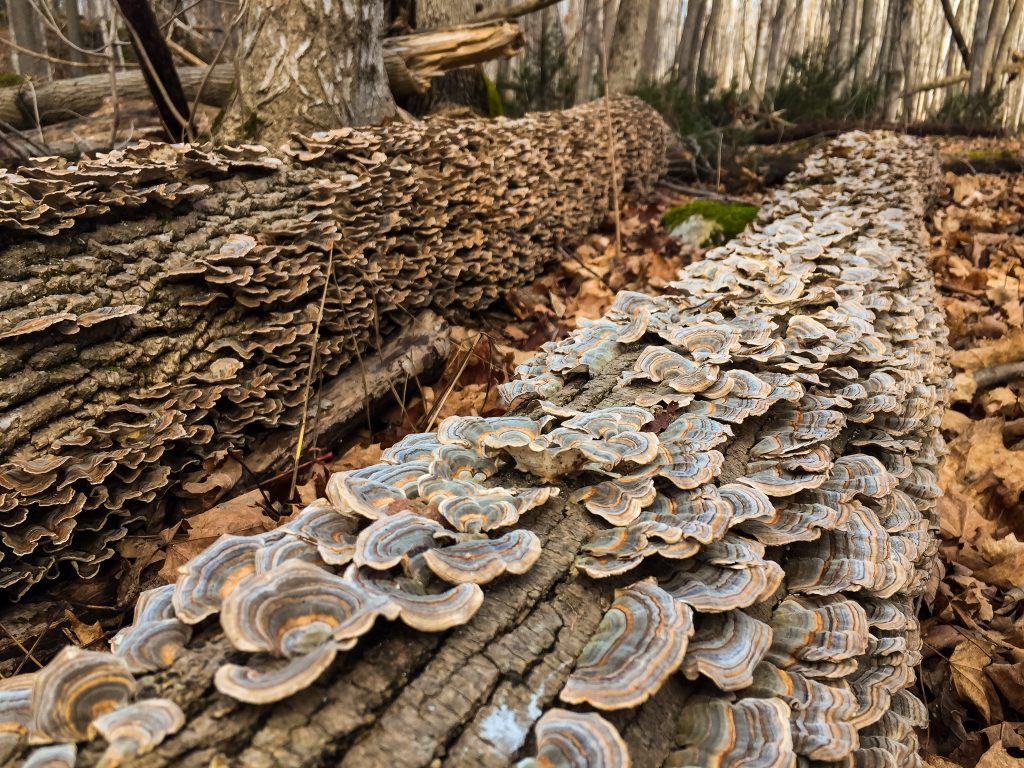
Like most mushrooms, they help connect the living world, by way of using their mycelium (or as Paul Stamets would say, the “earth’s natural internet”) to exchange communication, nutrients, and much else beneath the surface, and the same happens when we consume it.
Thousands of years ago, Turkey Tail was first used in Traditional Chinese Medicine as a way to replenish chi (vital life energy), clear dampness and stagnation, and strengthen the respiratory system.
Nowadays, it is often used in a similar fashion – to promote and support a healthy liver, digestive system, and immune function, but it is due to its actions as an immuno-modulator and cancer medicine that has made it the most widely researched medicinal mushroom.

Now, I could talk about the benefits for days – but I’ll let the research speak for itself. Instead, I’d love to share with you how I most often use my foraged Turkey Tail!
If you’re in Southern Ontario like I am, picking at the end of November is often a great time to collect some fresh Turkey Tail. Though keep in mind, like foraging for anything, a careful hand goes a long way in maintaining the integrity of the medicine itself, and the community around it – in this case, moving mindfully so as not to disrupt the bark layer underneath it. Before getting carried away with the excitement that often comes along with mushroom foraging, make sure to always leave some behind (I like to keep the ancient Iroquois’ Seven Generations Philosophy in mind, whereby the decisions we make today should result in a sustainable world seven generations into the future).
Once you have some, it’s about as versatile as it is impactful. Though, I like to predominantly use mine in one of two ways; either in long-simmering broths or as dual-extract tinctures. Oftentimes when I collect Turkey Tail, the days have gotten cold enough for our woodstove to be on, in which case I would keep a stewing pot on the stove, and let the sweet nectars of the earth brew all day long (combining with other veggies too, of course!).
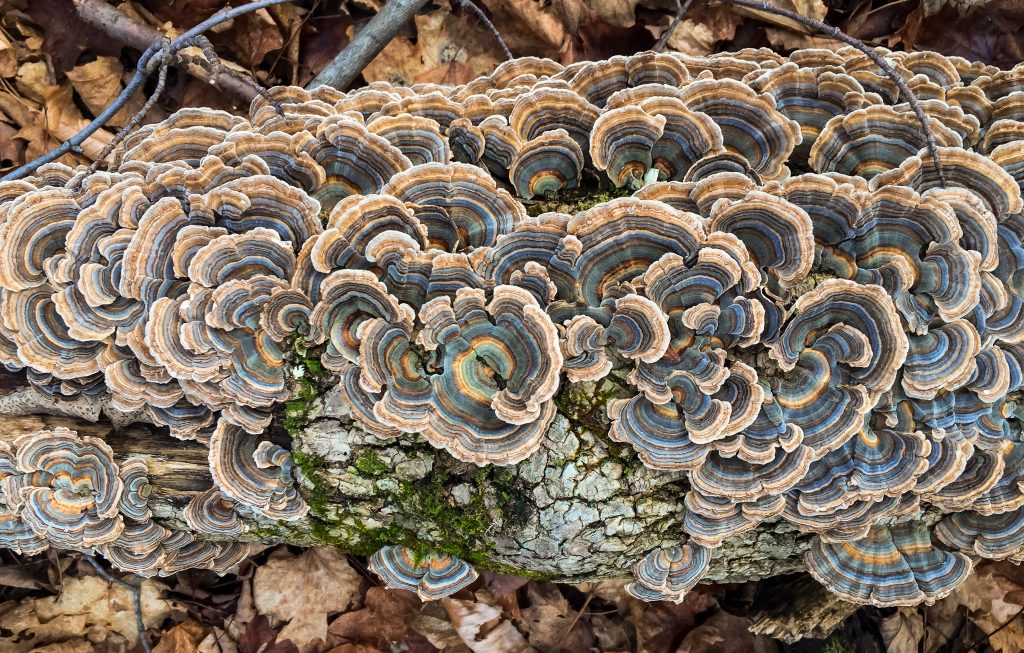
Though, another way fun way to use Turkey Tail is in mulled wines + ciders – which are exceptionally delicious this time of year! Similarly, I like to let mine sit on the woodstove overnight or all day if I’m home. Mixing in allspice, cinnamon, cloves, and any fresh fruit I have on hand.
But, at the end of the day, it’s more than just the medicine by way of taking it that can bring healing, but in the relationship you can build with the natural world and the start-to-finish process of getting out in nature, touching the mushrooms themselves, and getting to experience the rhythm of the world that was here long before us.
Photos by Chelsea Lise

